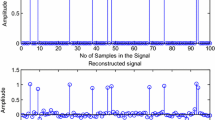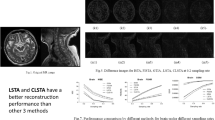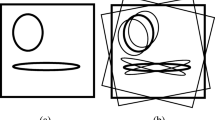Abstract
The application of compressed sensing (CS) to magnetic resonance (MR) images utilizes the transformed domain sparsity to enable the reconstruction from an under-sampled k-space (Fourier) data using a non-linear recovery algorithm. In order to estimate the missing k-space data from the partial Fourier samples, the reconstruction algorithms minimize an objective function based on mixed l 1 − l 2 norms. Iterative-shrinkage algorithms, such as parallel coordinate descent (PCD) and separable surrogate functional, provide an efficient numerical technique to minimize the l 1-regularized least square optimization problem. These algorithms require a thresholding step to induce sparsity in the solution, which is an essential requirement of the CS recovery. This paper introduces a novel soft-thresholding method based on the hyperbolic tangent function. It has been shown that by using the proposed thresholding function in the sparsifying domain and a data consistency step in the k-space, the iterative-shrinkage algorithms can be used effectively to recover the under-sampled MR images. For the purpose of demonstration, we use the proposed soft-thresholding and data consistency with the PCD algorithm and compare its performance with the conventional PCD, projection onto convex sets and low-resolution reconstruction methods. The metrics used to compare the various algorithms are the artifact power, the peak signal-to-noise ratio, the correlation and the structural similarity index. The experimental results are validated using Shepp–Logan phantom image as well as real human head MR images taken from the MRI scanner at St. Mary’s Hospital, London.











Similar content being viewed by others
References
J.A. Fessler, IEEE Signal Process. Magn. 27, 81–89 (2010)
E.J. Candes, M.B. Wakin, IEEE Signal Process. Magn. 25, 21–30 (2008)
E.J. Candes, J.K. Romberg, T. Tao, Commun Pur Appl Math 59, 1207–1223 (2006)
R.G. Baraniuk, E. Candes, R. Nowak, M. Vetterli, IEEE Signal Process. Magn. 25, 12–13 (2008)
M. Lustig, D. Donoho, J.M. Pauly, Magnet. Reson. Med. 58, 1182–1195 (2007)
M. Lustig, D.L. Donoho, J.M. Santos, J.M. Pauly, IEEE Signal Process. Magn. 25, 72–82 (2008)
V.M. Patel, R. Maleh, A.C. Gilbert, R. Chellappa, I.E.E.E. Trans, Image Process. 21, 94–105 (2012)
Ti-C Chang, L. He, T. Fang, in Proceedings of the 13th Annual Meeting of ISMRM, Seattle, p. 696 (2006)
Y.L. Montagner, E. Angelini, J-C. Olivo-Marin, in 2011 IEEE International Symposium on Biomedical Imaging: From Nano to Macro, Chicago, IL, USA, pp. 105–108 (2011). doi:10.1109/ISBI.2011.5872365
J. Huang, S. Zhang, D. Metaxas, Med. Image Anal. 15(5), 670–679 (2011)
A. Beck, M. Teboulle, Siam J. Imaging Sci. 2, 183–202 (2009)
M. Zibulevsky, M. Elad, IEEE Signal Process. Magn. 27, 76–88 (2010)
M. Elad, B. Matalon, J. Shtok, M. Zibulevsky, Proc. SPIE 6701, Wavelets XII, 670102 (2007). doi:10.1117/12.741299
M. Elad, B. Matalon, M. Zibulevsky, Appl. Comput. Harmon. Anal. 23(3), 346–367 (2007)
T. Blumensath, Signal Process. 92, 752–756 (2012)
G.A. Wright, IEEE Signal Process. Magn. 14, 56–66 (1997)
P. Mansfield, J. Phys. C Solid State 10(3), L55–L58 (1977)
H. Omer, R. Dickinson, Concepts Magn. Reson. A 38A(2), 52–60 (2011)
K.P. Pruessmann, M. Weiger, M.B. Scheidegger, P. Boesiger, Magn. Reson. Med. 42, 952–962 (1999)
J. Shah, I. Qureshi, H. Omer, A. Khaliq, Int. J. Imag. Syst. Tech. 24(3), 203–207 (2014)
A.A. Samsonov, E.G. Kholmovski, D.L. Parker, C.R. Johnson, Magn. Reson. Med. 52(6), 1397–1406 (2004)
M. Doneva, P. Börnert, H. Eggers, A. Mertins, in Proceedings of Joint Annual Meeting ISMRM- ESMRMB, Stockholm, Sweden, 4851 (2010)
M. Elad, in Sparse and redundant representations: from theory to applications in signal and image processing. (Springer, New York, 2010), pp. 302–304
Acknowledgments
We are grateful to Dr. Hammad Omer, Assistant Professor, Department of Electrical Engineering, COMSATS Institute of Information Technology, Islamabad, Pakistan, for providing the dataset of the real MRI scans of his head taken at St. Mary’s Hospital, London UK.
Author information
Authors and Affiliations
Corresponding author
Rights and permissions
About this article
Cite this article
Shah, J., Qureshi, I.M., Proano, J. et al. Compressively Sampled MR Image Reconstruction Using Hyperbolic Tangent-Based Soft-Thresholding. Appl Magn Reson 46, 837–851 (2015). https://doi.org/10.1007/s00723-015-0683-2
Received:
Revised:
Published:
Issue Date:
DOI: https://doi.org/10.1007/s00723-015-0683-2




